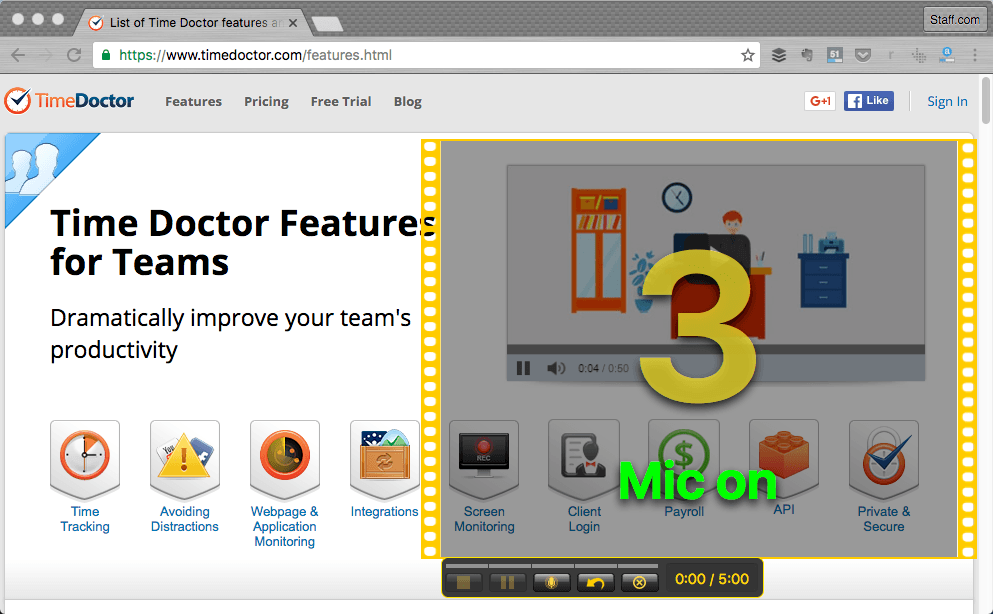I’ve been working with hundreds of virtual team members in over 9 different countries in the past 12 years. Managing remote employees sometimes made me want to tear my hair out.
But it’s also our greatest competitive strength. We can hire people from any location around the world which makes it a lot easier to hire talented people.
Sometimes I had no idea what my team was doing, or that team members would “flake out”–they’d work effectively for a while and then their quality of work would taper off or they’d quit, or I get frustrated about not being able to communicate with them effectively, or I had many issues finding and hiring great people remotely.
But now I know a lot more about how to make virtual teams work. The strategies I use reflect my years of experience figuring out what works best to keep the teams coherent, productive and motivated.
Top tips for managing remote teams
- Track hours worked, attendance and other basic measures of productivity
- Organize a system of overlapping times for communicating in different time zones
- Be wary of chat and email overload
- Use tools for quick video and visual communication
- Effective collaboration on documents and spreadsheets
- Create a standard onboarding process
- Meet in person
- More tips below
See how Time Doctor’s easy-to-use time tracking software can help your team be more productive.
These strategies on how to manage virtual teams are what we use at Time Doctor, where we have over 50 full-time global team members all working virtually, remotely, to create the best remote management and productivity software for individuals and businesses.
Productivity

Tip 1: Track hours worked, attendance and other basic measures of productivity
If you are paying based on hours worked, then it makes a lot of sense to track how many hours each person works.
In an office environment you can see who is coming in each day even if you are not tracking attendance. In a completely virtual environment it can be difficult to understand exactly what is going on, how long each person worked, and what they are working on.
Some people are extremely disciplined and can get to work on time, stay on task, and avoid all distractions. However, most of us, including me, need some accountability. We need to “clock in” and make sure we avoid distractions like Facebook or YouTube.
We built the Time Doctor software to make sure that your team members are working on the tasks at hand. With Time Doctor, you can see what projects are being working on (in real time), which websites team members are visiting, applications being used, and even time spent working and time on breaks. Time Doctor can show you for example whether a team member is working or chatting with friends on Facebook.
Click here to try Time Doctor free for 14 days and watch your team become more productive and your business become more profitable. (No Credit card required)

Tip 2: Implement systems
Without systems, your business can fall apart. A business run in an office can compensate to some degree for not having systems and processes simply by the fact that people can talk in person and look over each other’s shoulders. In a virtual team, each person can be in their own world. They may develop their own processes and procedures that don’t mesh with the way other team members are working. It’s best to have a documented, standardized way of working that you’re constantly refining.
For example in our business, developers follow a very specific process for suggestions, building, testing and documentation.
Tip 3: Allow a degree of flexible work hours but also keep some consistency
People working from home will rightly want flexibility with their work hours. And it’s important to allow a degree of flexibility when managing remote employees. On the other hand, if things are totally erratic then it will be difficult to get a shared collaboration window when all of your team are online at the same time and able to chat.
Tip 4: Track work output
Whether your team is virtual or not, you need to try to measure their productivity. What are the key indicators of success for each job? Get transparency around this so that you will know quickly (in a couple of weeks and not in 6 months) whether each team member is being productive or not. Tools like SalesHandy are useful for this especially if you want a streamlined communication and analytics for a remote sales team.
Tip 5: Organize a system of overlapping times for communicating in different time zones.
Timezones can kill communication in a remote team. If members of your team work in different time zones, then make sure that you have an overlapping period where everyone is working and organize your virtual meetings during these times.
However this might not be enough. Depending on the type of work you are doing you may want to consider only hiring people in the same timezone or where the time is only 3 hours apart. Especially from within one team. Most teams needs to be constantly collaborating to be effective and a large time zone difference between team members will kill the collaboration.
Tip 6: Do a quarterly review to see how your virtual team members are coping
One of the issues with working from home is that people can feel lonely and isolated. Not everyone copes well with this style of working. Most people do not have this issue and love the freedom that comes with working from home, but it’s important to check in from time to time and make sure everything is working for them.
Communication

Tip 7: Compensate for the fact that you are not bumping into each other
One of the biggest reasons why virtual teams fail is because they don’t compensate the fact that team members are not bumping into each other. They kind of forget about the other team members, live in their own world and do not communicate or collaborate as much as they need to.
In a virtual environment, you need to create opportunities for team members to just “chat” both formally and informally. So this means that you need to actually over-communicate and create opportunities such as regular meetings for everyone to chat.
Tip 8: Have a chat room open constantly
In our business we have a chat room open for each team in the business. Team members leave messages for the team that they are a part of. It’s essential to keep these chats alive but not distracting. There’s enough conversation to be able to discuss important issues and to feel like we’re connected as one team, but not so much that it becomes distracting.
We also have a fun company wide chat room open for non business related chat. This creates a bit of a water cooler effect where employees can chat about anything they like. It can be a lonely existence working by yourself at home and this company wide chat helps keep a feeling of social connection.
The three most common options for chat software are: Slack, Skype and HipChat. All of these are great options and worth considering, Skype is possibly better if you want a free option, but it lacks some of the benefits of Slack in terms of integrations and getting your company organized.
Tip 9: Be wary of chat and email overload
This is a hard one because on the one hand you need to make sure everyone is communicating enough, but on the other hand it can get distracting and overwhelming. Make sure that team members are not subscribed to too many channels and instead are only receiving the messages that they need to see.
Tip 10: Choose the right communication style
Depending on your needs, choose the type of communication that works best.
- Email – For quick interactions. You can also replace most email communication with other tools such as project management tools or chat programs.
- Chat programs – Skype or Google Hangouts are great for quick instant messages where you need real-time interaction.
- Video chat – Some types of communication should only be handled over with voice. Any kind of emotional issue such as performance problems should be handled over the phone. Video chat would be even better as it gives you more visual cues of what is going on with the other person. It can feel isolating and abnormal to chat only with text and adding video makes your remote company feel more “real”.
- VoIP – Virtual phone systems centered on cloud technology that allow for quick and easy calling, messaging, and task management. Also typically come equipped with dozens of call functions to make the calling experience as smooth as possible.
- Project management tools – These keep your communication a lot more organized and so that you are able to reference it and refer to it later on. Or perhaps when people join the company they can see the previous discussion points.
- Creating a short video – It’s very easy to create a video of yourself on YouTube using your webcam, or using a screen capture tool such as Jing.
Tip 11: Use tools for quick video or visual communication

When you’re not in the same room how can you explain something visually on your computer screen? A YouTube video or a screen capture tool like Jing is a great way to do this. Capture desktop screenshots and put arrows, labels and notes using Jing or create quick screen capture videos and share it with other team members via YouTube. You can also create explainer videos for much clearer communication.
Tip 12: Use screen sharing tools
There are tools that enable you to share your screen so that another person can see exactly what you are doing. Some of these tools even allow people to control another computer remotely. Many of these tools are free-to-use for small teams, including TeamViewer and Join.me. Skype, Slack and Google Hangouts also have screen sharing capability but without any option to control another computer remotely.
Tip 13: Video conferencing technologies
It’s essential that you regularly chat on video within your team. Imagine that you came into a normal office and you put a balaclava over your head and didn’t chat to anyone or show your face. That’s kind of how it’s like if you never chat on video. To connect as a team, video chat is essential.
There are lots of technology options for video chat: Google hangouts, Slack, Skype and Zoom are a few alternatives. In my opinion Zoom is probably the best technology, it has dozens of small optimizations that improve your remote communication.
Tip 14: Set up a meeting rhythm
You need to have a meeting rhythm. This means a regular meeting within each team and an “all hands” meeting for the entire company. The exact frequency depends on the person and type of job, but I would recommend the following minimum meetings:
- A daily meeting within each team (quick, less than 10 minutes just to say hi and feel like you are connecting and to make sure there is nothing blocking each person from achieving their goals).
- A weekly meeting within a team or a weekly one-on-one meeting between a team leader and each person on their team. This weekly meeting is a way to store up issues and minimize the back and forth email that takes place during the week and handle it all in one meeting.
- A weekly all-hands meeting for the entire company. This should be short, usually 10 minutes to feel like your all part of the same team and to get on the same page.
Tip 15: Effective collaboration on documents and spreadsheets
If you have a document that is being edited by many people, Google Drive is the best option. If you have a document that just needs to be shared, and will not be edited simultaneously, then you can place your documents (such as an excel file) in a shared Google Drive or in Dropbox. Many project management tools also have file sharing and collaboration features, so that’s another alternative for collaborating on documents.
Tip 16: Set up a project management system, and actually use it
For smaller teams you might be tempted to wing it and handle everything via email. This is dangerous. Project management systems are helpful in managing virtual teams because they help to organize documents and conversations into projects, making it easier to find them later. They also help with organizing and storing shared files. If you run your business purely with emails it can quickly become an unmanageable, disorganized mess.
Hiring

Tip 17: Test new employees with short-term work before hiring them full time
You don’t need to hire someone full time right off the bat. You can get a taste of working with someone by hiring them for a small project, and then when it’s completed if you’re happy move on to full time work. It’s important that you do move on to full time work because if you have someone on part time or on a temporary project, their attention will be divided. It’s quite possible they will no longer be available just when you need them most. My experience is that staff who are working part time eventually drop off and stop working altogether. Full time people are relying on your company for their livelihood and are more likely to stick with you long term.
Tip 18: Pay virtual team members well
There are a lot of people who want to work virtually. Many professionals are willing to take a pay cut for the opportunity to work from home. While it’s true that you can find lower-cost team members virtually, if you pay them well, you’ll ensure that your team works hard and sticks with you for the long term.
Tip 19: Look for people who are the right fit for virtual work
Take a look at their environment at home. Do they have a quiet place to work? Are they constantly distracted by children in the house? On the other hand are they living at home by themselves and unable to get out and spend time with friends? Both distractions and isolation can be issues and it’s important to make sure that your team is happy & productive working from home.
Tip 20: Create a standard on-boarding process for educating new employees about your company
If you’re hiring employees remotely then they are not going to get the same kind of “learn by watching over the shoulder” method that can happen in an office. So when you hire someone, make sure that they have a training program (videos can work well) that educates them about your company and the way that you do things. Do as much as you can to get them adjusted to your company and to learn how to perform in their role. You should also have new employees interview customers to better learn how your product helps them.
Culture
Tip 21: Inspire via video
Remote workers can miss the feeling of a company culture. It’s difficult to create and maintain culture through written words alone. It’s much more powerful to create videos and use video conferencing services such as Google Hangouts. You can record hangouts for future employees as well. Use videos as a way to inspire your team, and to reinforce core concepts in your company culture (such as your company vision and mission).
Tip 22: Meet in person

It’s hard to develop true friendships remotely. Meeting in person about 4 times per year or as often as possible is the best way to create stronger bonds within your company. Joining conferences for remote teams greatly help too!
Tip 23: Nurture virtual friendships
Don’t forget that your team are human beings wired to connect with others. People can get connected from outside of work but it’s great to fill some of this need at work as well, much more in a virtual team. In my experience, this is especially important in jobs that do not involve as much human contact, such as in software development.
You may consider virtual team building activities to be able to do this too.
Tip 24: Create a true “team” feeling
When working virtually it may take extra effort to keep people feeling committed to their team. They need to know that not only they’re contributing true value to the team’s common goal; they are also valuable to the team’s success in achieving its goal. Some ways to achieve this are:
- Having and maintaining non-work related communication
- Sharing the future vision of the company
- Keeping your team informed about how the company is doing. People like to know what’s happening in other parts of the company and how they themselves fit in and are contributing to the bigger picture
- Get everyone in your team involved in important events and projects
- Start a conversation-sparking weekly trivia contest via Water Cooler Trivia
- During birthdays and special occasions, send gifts with meaning.
Anything you can do to create a feeling that they are not just working separately but are truly part of your company and part of a team is worthwhile.
Tip 25: Beware of a mixed office and remote culture
When your entire team is remote you will adjust more easily because you have to and you will be forced to implement strategies that work for a remote team. However when you have half of the team in an office and the other half remote it can cause problems. For example your office team might decide to hold a quick meeting and leave out the remote team members who end up not having their voice heard.
So you need to make sure that ALL of your meetings are remote friendly. This means you all log into Zoom or whatever technology you are using and chat together through your computer. You don’t have some people in the room and some remote.
Tip 26: Clear communication
Users must try to be as clear as possible in team meetings or 1 to 1 meetings. The best way to do that is by writing minutes of meetings so later no one has to poke others to confirm what was discussed. Also use better communication channels while discussing. Make sure you know when to use calls, emails or just chats.
“A call is always better than a hundred messages long to chat to discuss a marketing campaign. Similarly, email is not a good medium to talk about an urgent task, a call or Slack chat would work in that case.” — Arsalan Sajid, Agency Partnership Program Manager at Cloudways

Rob Rawson is a co-founder of Time Doctor which is software to improve work productivity and help keep track of what your team is working on, even when working remotely.


